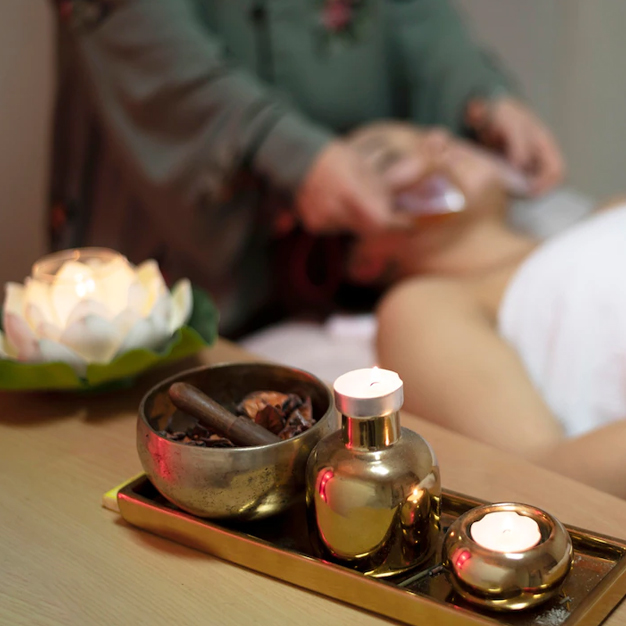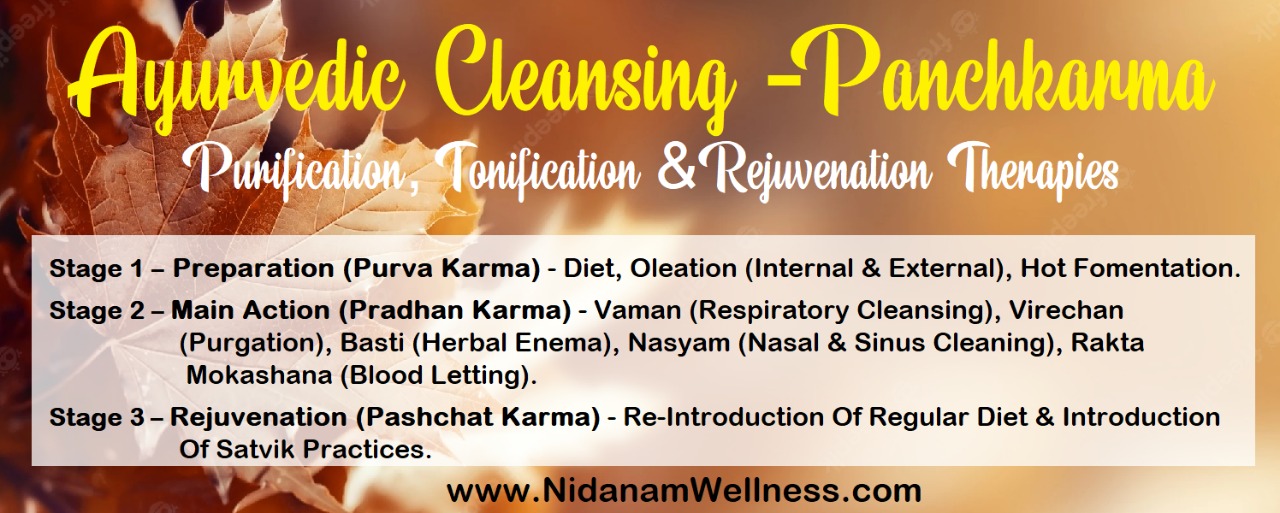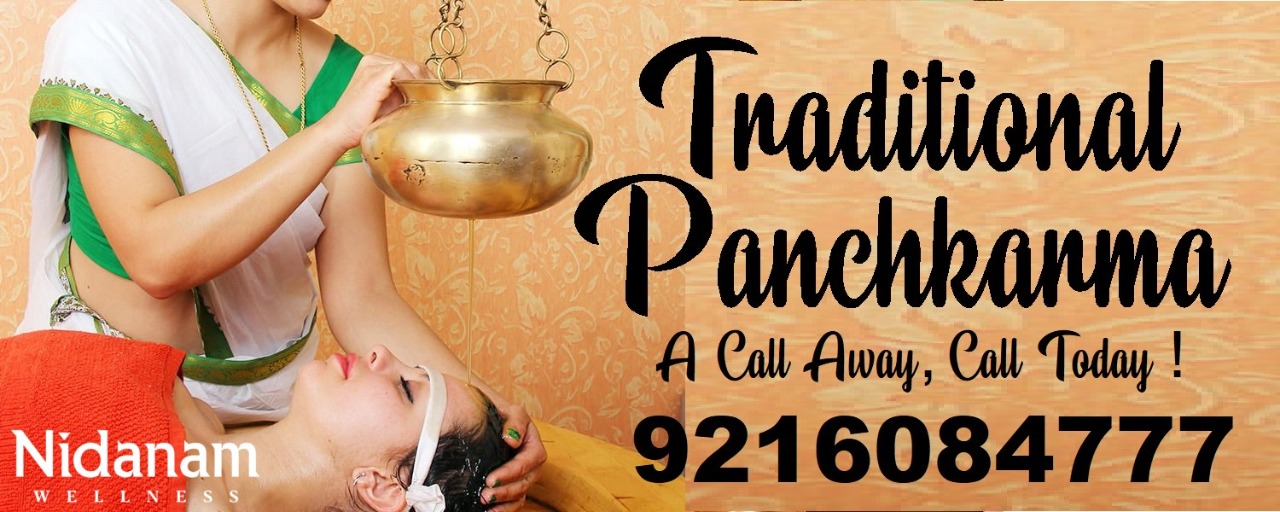
These days there are lots of calls and messages from people who are curious to know about panchkarma. Some people directly ask to book their appointment for panchkarma, considering panchkarma a body massage.
Panchkarma is not merely an ayurvedic body massage but a complete ayurvedic treatment protocol that needs medical supervision. Stressful lifestyles and emotional outbreaks have created a huge demand for wellness programs. Ayurveda is no doubt the most credible wellness-centric program that not only improves the body but is also helpful in treating various diseases. To catch up with this trend, several massage centres have started promoting themselves as panchkarma centres, creating a false perception of panchkarma being a massage.
Let’s first explore, what exactly is this panchkarma.
Panchkarma, in one sentence, can be described as a method that helps in eliminating toxins from the body. It is a set of five activities as described in shastras (ancient ayurvedic texts) hence it got its nomenclature. Here, before describing panchkarma in detail, let’s first understand the meaning of the word “toxin” according to Ayurveda.
See what our clients say
I am happy with my back pain treatment at Nidanam wellness clinic. I was suffering from back pain for two years. MRI showed a nerve compression. With panchkarma and ayurvedic treatment, my back pain is gone in just 14 days. Recommended to all.
–Hitesh
I want to thank Dr. Jyotiraditya for treating my sciatica problem. I was suffering from sciatica since my college days and traveling had become a challenge. With 7 days of panchkarma treatment. My sciatica problem is all gone. Thanks to the Doctor again.
–Rohan
Understanding all about Panchkarma
Toxins, contrary to the modern dictionary definition, in Ayurveda is defined as anything alien to the body. This so-called alien element thus is the culprit of disturbing the physiology and/or anatomy of the body. This disturbance in body is measured in the parameters of vata, pitta and kapha (called the tridoshas) in Ayurveda.

Dr. Jyotiraditya Agarwal is a Nadi Vaidya (pulse diagnosing doctor) and hence he specializes in treating various diseases, judging the discrepancies brought about by alien substances to disturb the harmony of the tridoshas.
Coming back to the topic, imbalances in these doshas, according to the shastras (ancient ayurvedic texts) are the real reasons for the onset of any diseases. To make body disease free, these vitiated doshas should be harmonized.
Hence, the methods by which these vitiated doshas are harmonized come under panchkarma. Subsequently, understanding the meaning of toxin, now let’s redefine panchkarma.
Panchkarma is a part of Ayurvedic treatment protocol wherein, with the usage of five activities (as the name also suggests, Panch means five and karma mean activities), a disease is treated and eliminated from the body.
Panchkarma or panchakarma procedures are classified into three parts.
1. Purva karma (pre-panchkarma activities) – this phase is referred to as the preparation of the body, to make it ready for the Pradhan karma i.e. the panchkarma. Snehan (oleation-
use of oil, externally or internally) and Swedan (hot fomentation) comes in this category. The popular panchkarma procedure referred to as abhyanga is an ayurvedic massage that falls in this category.
2. Pradhan karma (main activities of panchkarma) –is referred to as the key practice that is administered to bring about the required detoxification in the body. It involves five parts. These are Vamana, virechana, basti, nasayam and raktmokshana. It depends on the wisdom of a Vaidya (ayurvedic physician) to use these singly or in combination to accomplish the desired detoxification.
3. Pashchat karma (post-panchkarma activities) – this phase is referred to as the post-operative or post-panchkarma activity. The goal of this activity is to make the body recover to normalcy and also to strengthen it for faster recovery. This phase is more related to dietary or lifestyle alternation and the use of ayurvedic medicines as well. This aftercare is vital to accomplish the desired result.
I think, by now, there is a basic understanding of panchkarma. But here comes another question in mind, why there is a need to go about with panchkarma?
There are various benefits of panchkarma
1. As the toxins are not normal to the body, hence eradication of these toxins helps in developing good coordination of mind and body.
2. It induces strength and also helps in restoring the original disease-free state in coordination with the prakruti of the body.
3. As described earlier, if the physical doshas i.e. vata pitta and kapha are stable and in harmony, the body remains healthy, hence panchkarma balances doshas.
4. Panchkarma helps in unclogging the energy channels and chakras, which due to toxins get clogged thereby inhibiting the natural energy flow of the body.
5. According to Ayurveda, if the digestion of a person is up to the mark, he may be immune to various diseases. Panchkarma helps in optimizing the working of the digestive tract, thus maintaining the body’s disease-free state.
6. Post corona, the value of immunity is now understood by all. Panchkarma helps in enriching the immunity levels that tackle disease-causing agents.
7. Panchkarma helps in reinstating the mobility of the joints and also improves blood circulation.
8. Panchkarma has been found proficient in enlightening the state of mental muddle caused by instability of manas doshas (Satva, rajh, and tamas) that are the primary contributor to problems like stress, depression, and insomnia.
According to Ayurveda, these toxins or waste materials are called “ama”. These “ama” or toxins contribute to the deterioration or decay of the body organs, thus inviting diseases to invade the body and also causing early aging.
Panchkarma by its various methods helps in eliminating these “ama”. The different routes through which these toxins get eliminated from the body are the colon, lungs, bladder, sweat glands, urinary tract, intestines and stomach.
This method of detoxification may take a minimum of seven days to eliminate the toxins. Besides this, amendments in diet and lifestyle are also necessary.
Why is it necessary to clean up deep inside the body?
The world is full of microorganisms that are accountable to bring about the breakage and degeneration of any organic material. It is a recognized fact that anything having an organic origin would break down into a simple form from a complex state. This process is known as decay and fermentation. During this breakdown, several poisonous or undesired chemicals and gases are released into the body that might prove harmful or even fatal.
Therefore, it becomes fundamentally important to deep clean the body at the cellular level. Also considering the present environmental conditions, the human body is exposed to pollutants and other harmful chemicals through food, water, and air. This build-up of unwanted substances in the body, disrupts the natural bodily activities making it sick and diseased.
With the cleansing activities of panchkarma, toxin build-up in the body can be eliminated to preserve the synchronization of physical doshas (vata, pitta and kapha) as well as the mental doshas (Satva, Rajh, and tamas) to bring about a healthy environment in the body.
How do I know that my body requires cleaning?
The body does indicate that it requires detoxification with various signs mentioned below.
1. Severe indigestions are indicated with frequent constipation or diarrheal episodes along with loss or excessive hunger.
2. Bad breath and coated tongue.
3. Smell in sweat
4. Unable to take the decision and a condition of a stuck mind.
5. Undesired Fatigue and pains in the body.
6. Excessive lethargies
7. Lack of lustre and glow on the skin
8. Uncontrollable cravings.
9. Frequent overreactions, stress, emotional upset, panic attacks etc.
10. Loss of libido
Classification of Panchkarma
As per the utility, Panchkarma can be classified into two categories.
1. Classical deep ayurvedic panchkarma
2. Classical external ayurvedic panchkarma
Classical deep ayurvedic panchkarma
This category of panchkarma involves the removal of deep-seated toxins. This classical deep panchkarma is further divided into five types which are based on the approach of doshas to be eliminated from the body.
1. Vamana – Vamana is a process in which the physical doshas i.e vata, pitta and kapha are eliminated from the upper part of the digestive tract i.e. mouth. In general language, it is eliminating doshas via mouth which by appearance is similar to vomiting, though technically it cannot be called vomiting as it is induced to eliminate doshas and not to puke the food out. According to shastras (ancient ayurvedic texts), this process is done to eliminate vitiated kapha dosha, still, it depends on Vaidya’s wisdom, and how he desires to use this panchkarma process for detoxification.
1. Virechana – virechana is a process by which doshas are eliminated from the lower part of the digestive tract i.e. anus. In common language, it is the elimination of doshas by inducing loose stools. Technically, it cannot be considered as loose motion as it is induced in such a way that doshas get eliminated. In general, ancient texts suggest the virechana process for eliminating pitta dosha, still, a wise Vaidya knows its application in various other conditions of the body.
2. Basti or vasti- this is the most celebrated panchkarma activity owing to its tremendous healing capacity. Basti is done to tackle vitiated vata dosha that contributes to most diseases in the body. Basti is further classified into two subtypes. Anuvasan basti and niruh basti. Basti karma is considered the best tool to counter the uncontrolled Vata in the body. Generally, all kinds of pain issues can be treated with this panchkarma activity, as pains are directly related to vitiated vata. Still, a wise Vaidya knows its application, and it is up to him to consider it in other ailments as well.
3. Nasyam – nasyam is done to eliminate doshas from the paranasal sinuses. It helps in combatting allergies and helps in reducing nasal as well as respiratory congestions. It is useful in treating asthma, migraines, etc.
4. Rakt mokshana – raktmokashana is a process of panchkarma that is mentioned in Sushruta Samhita. It is fundamentally used to eliminate toxic and infected blood. It is also helpful in improving blood circulation. In case of any clotting or stagnation in blood circulation, leeches or jalauka treatment is done.
Classical external ayurvedic panchkarma
Ayurveda has two basic principles, one, is to maintain the health of a healthy person, second, is to treat a diseased individual. The external ayurvedic panchkarma activities help primarily in achieving the first principle of Ayurveda. But it may have many other applications as the wisdom of the Vaidya suggests.
1. Abhyangam (ayurvedic body massages) – application of medicated oil on the body is called abhyanga. It is again a technical process, wherein a technique is required to get the oil (medicated) to penetrate the body and not just to barely rub the body.
2. Swedana – swed means sweating. There are 14 as mentioned by Rishi Vagabhatta by which sweating is induced to open the clogged sweat glands and skin pores. This also helps in throwing out toxins and also to increases blood circulation. Patra Potli pind swed, Shashti shali pind swed are the most popular swedan therapies.
1. Udvartanam – udvartana is a type of external panchkarma that is done to scrape off the toxins located beneath the skin. It is popularly done for people having obesity and weight issues. It has various other applications as well. A wise Vaidya can use this process in several body conditions to make the body disease free. It is done with herbal powders.
1. Pizichil – pizichil is a panchkarma process that purely deals with oil. Pouring oil on the body is a very pleasant experience. It is also helpful in treating various vata-related problems.
1. Kati/ janu / greeva vasti – one of the most glorified panchkarma processes, which has gained extreme popularity due to its effectiveness in the treatment of spinal issues and joint pains condition. It is named as per the body part it is used on.

